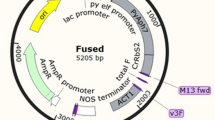Abstract
With a photocatalyzed characteristic, nanoanatase TiO2 under light could cause an oxidation–reduction reaction. Our studies had proved that nano-TiO2 could promote photosynthesis and greatly improve spinach growth. However, the mechanism of nano-TiO2 on promoting conversion from light energy to electron energy and from electron energy to active chemistry energy remains largely unclear. In this study, we report that the electron transfer, oxygen evolution, and photophosphorylation of chloroplast (Chl) from nanoanatase-TiO2-treated spinach were greatly increased under visible light and ultraviolet light illumination. It was demonstrated that nanoanatase TiO2 could greatly improve whole chain electron transport, photoreduction activity of photosystem II, O2-evolving and photophosphorylation activity of spinach Chl not only under visible light, but also energy-enriched electron from nanoanatase TiO2, which entered Chl under ultraviolet light and was transferred in photosynthetic electron transport chain and made NADP+ be reduced into NADPH, and coupled to photophosphorylation and made electron energy be transformed to ATP. Moreover, nanoanatase h+, which photogenerated electron holes, captured an electron from water, which accelerated water photolysis and O2 evolution.


Similar content being viewed by others
References
Crabtree RH (1998) A new type of hydrogen bond. Science 282:2000–2001
Kuang TY (ed) (2003) Mechanism and regulation of primary energy conversion process in photosynthesis. Science and Technology Press of Jiangsu, Nanjing, pp 22–68 (in Chinese)
Campbell WM, Burrel AK, Officer DL et al (2004) Porphyrins as light harvesters in the dye-sensitised TiO2 solar cell. Coord Chem Rev 248:817–833
Li M, Wang ZL, Shi HZ, Zeng Y (2003) Surface morphology, spectra and photocatalytic bactericidal effect of chlorophyll-sensitizing TiO2 crystalline phases. Journal of Inorganic Materials 18(6):1261–1266 (in Chinese)
Zheng L, Hong FS, Lv SP et al (2005) Effect of nano-TiO2 on strength of naturally aged seeds and growth of spinach. Biol Trace Elem Res 104(1):82–93
Hong FS, Yang P, Gao FQ et al (2005) Effect of nano-TiO2 on spectral characterization of photosystemII particles from spinach. Chem Res Chin Univ 21(2):196–200
Hong FS, Zhou J, Liu C et al (2005) Effect of nano-TiO2 on photochemical reaction of chloroplasts of spinach. Biol Trace Elem Res 105(3):269–280
Hong FS, Yang F, Ma ZN et al (2005) Influences of nano-TiO2 on the chloroplast ageing of spinach under light. Biol Trace Elem Res 104(3):249–260
Gao FQ, Hong FS, Liu C, Zheng L, Su MY, Wu X, Yang F, Wu C, Yang P (2006) Mechanism of nano-anatase TiO2 on promoting photosynthetic carbon reaction of spinach: inducing complex of Rubisco–Rubisco activase. Biol Trace Elem Res 11(1–3):239–254
Yang P, Lu C, Hua N, Du Y (2002) Titanium dioxide nanoparticles co-doped with Fe3+ and Eu3+ ions for photocatalysis. Mater Lett 57:794–801
Arnon DI (1949) Copper enzymes in isolated chloroplasts. Polyphenol oxidase in Beta vulgaris. Plant Physiol 24:1
Aravind P, Prasad MNV (2004) Zinc protects chloroplasts and associated photochemical functions in cadmium exposed Ceratophyllum demersum L., a freshwater macrophyte. Plant Sci 166:1321–1327
Tang XS, Satoh K (1985) The oxygen-evolving photosystem II core complex. FEBS Lett 179:60–64
Neelima A, Pardhasaradhi P, Mohanty P (1991) Inhibition of chloroplast photochemical reactions by treatment of wheat seedlings with low concentrations of cadmium: analysis of electron transport activities and changes in fluorescence yield. Plant Cell Physiol 32(7):943–951
Allnutt FCT, Ewy RG, Renganathan M, Pan RS, Dilley RA (1991) Nigericin and hexylamine effects on localized proton gradients in thylakoid. Biochim Biophys Acta 1059:28–36
Lasson CM, Olsson T (1979) Firefly assay of adenine nucleotides from algae: comparison of extraction methods. Plant Cell Physiol 22:145–155
Wu WH (2003) Plant physiology. Science Press, Beijing, pp 117–143
Acknowledgments
This work was supported by the National Natural Science Foundation of China (grant nos. 20671067 and 30470150) and by the Jiangsu Province Universities Natural Science Foundation (grant nos. 06KJB180094 and 03KJB180122).
Author information
Authors and Affiliations
Corresponding author
Rights and permissions
About this article
Cite this article
Lei, Z., Mingyu, S., Chao, L. et al. Effects of Nanoanatase TiO2 on Photosynthesis of Spinach Chloroplasts Under Different Light Illumination. Biol Trace Elem Res 119, 68–76 (2007). https://doi.org/10.1007/s12011-007-0047-3
Received:
Accepted:
Published:
Issue Date:
DOI: https://doi.org/10.1007/s12011-007-0047-3




